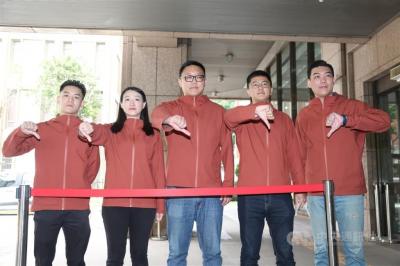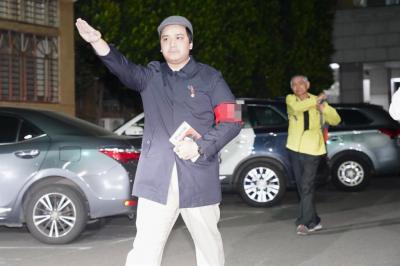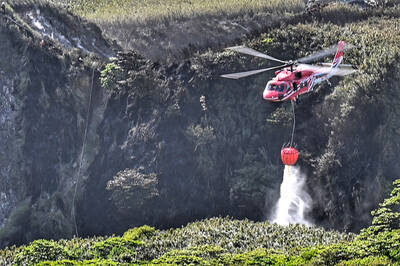On the 71st anniversary of the end of World War II in Asia yesterday, pro-localization groups again urged the government to establish a memorial park and a monument to commemorate the Taiwanese who died in the Japanese campaign, a history that they said was deliberately neglected by the Chinese Nationalist Party (KMT) regime.
Advocates and academics said the memorial park and monument should be built to counter the historical narrative imposed by the KMT regime that stressed the Republic of China’s role in the Second Sino-Japanese War, while the forgotten history of Taiwan in World War II involved Taiwanese conscripts fighting for Japan across Asia and the Pacific, as well as Allied air raids on Taiwan.
According to the Japanese Ministry of Health, Labor and Welfare, a total of 207,183 Taiwanese served in the military of Imperial Japan either as soldiers or in noncombat capacities, of whom 30,300 were killed in action and more than 20,000 were missing in action.
“The number of Taiwanese war dead was more than those persecuted in the 228 Incident, but there has been no memorial service in Taiwan to commemorate wartime victims,” Aletheia University professor Chen Li-fu (陳俐甫) said.
“Some Taiwanese have been criticized for paying tribute to Taiwanese war dead enshrined in the Yasukuni Shrine in Japan, but there is no monument to commemorate them in Taiwan,” Chen said.
Taiwan’s wartime history was neglected and distorted to serve the KMT regime’s China-centric narratives, and the nation has yet to face its wartime history to bring about transitional justice and reconciliation, Taiwan Association of University Professors chairman Peter Chang (張信堂) said.
“It was not until last year, when the association held an exhibition about US air raids on Taiwan during World War II, that many Taiwanese realized Taiwan was ever bombed by the Allies. They came to understand that their history was dramatically different from what was taught in schools,” Chang said.
Taiwanese have been taught history that is not closely relevant to Taiwan, and few people know that more than 20,000 Taiwanese are enshrined in the Yasukuni Shrine, National Chengchi University history professor Hsueh Hua-yuan (薛化元) said.
Taiwan Tower, a monument to remember Taiwanese servicemen fighting for Japan, was unveiled in Japan’s Okinawa Prefecture in June, and there is a similar monument in the Philippines, but Taiwan does not have its own memorial park and monuments to remember that history, they said.
While countries remember World War II with a variety of ceremonies and works of art, Taiwan is oblivious to its wartime past, New Power Party Legislator Freddy Lim (林昶佐) said.
Taiwan suffered great losses during the war, as more than 3,000 civilians were killed in the Taipei Air Raid on May 31, 1945, Lim said, adding that 173 Taiwanese were convicted as war criminals.
“Taiwan does not have any national-level memorial for its wartime history. Even now, attempts to address Taiwan’s wartime history will be stigmatized. However, it is time that we remember that history,” Lim said.
A monument could be built on the green plot in front of the Huashan 1914 Creative Park in Taipei, which used to be a train station and a military factory during the Japanese colonial era, he said.

Taiwan is stepping up plans to create self-sufficient supply chains for combat drones and increase foreign orders from the US to counter China’s numerical superiority, a defense official said on Saturday. Commenting on condition of anonymity, the official said the nation’s armed forces are in agreement with US Admiral Samuel Paparo’s assessment that Taiwan’s military must be prepared to turn the nation’s waters into a “hellscape” for the Chinese People’s Liberation Army (PLA). Paparo, the commander of the US Indo-Pacific Command, reiterated the concept during a Congressional hearing in Washington on Wednesday. He first coined the term in a security conference last

Prosecutors today declined to say who was questioned regarding alleged forgery on petitions to recall Democratic Progressive Party (DPP) legislators, after Chinese-language media earlier reported that members of the Chinese Nationalist Party (KMT) Youth League were brought in for questioning. The Ministry of Justice Investigation Bureau confirmed that two people had been questioned, but did not disclose any further information about the ongoing investigation. KMT Youth League members Lee Hsiao-liang (李孝亮) and Liu Szu-yin (劉思吟) — who are leading the effort to recall DPP caucus chief executive Rosalia Wu (吳思瑤) and Legislator Wu Pei-yi (吳沛憶) — both posted on Facebook saying: “I

Sung Chien-liang (宋建樑), who led efforts to recall Democratic Progressive Party (DPP) Legislator Lee Kun-cheng (李坤城), was released on bail of NT$80,000 today amid outcry over his decision to wear a Nazi armband to questioning the night before. Sung arrived at the New Taipei District Prosecutors’ Office for questioning in a recall petition forgery case last night wearing a red armband bearing a swastika, carrying a copy of Adolf Hitler’s Mein Kampf and giving a Nazi salute. Sung left the building at 1:15am without the armband and covering the book with his coat. Lee said today that this is a serious

A mountain blaze that broke out yesterday morning in Yangmingshan National Park was put out after five hours, following multi agency efforts involving dozens of fire trucks and helicopter water drops. The fire might have been sparked by an air quality sensor operated by the National Center for High-Performance Computing, one of the national-level laboratories under the National Applied Research Laboratories, Yangmingshan National Park Headquarters said. The Taipei City Fire Department said the fire, which broke out at about 11am yesterday near the mountainous Xiaoyoukeng (小油坑) Recreation Area was extinguished at 4:32pm. It had initially dispatched 72 personnel in four command vehicles, 16